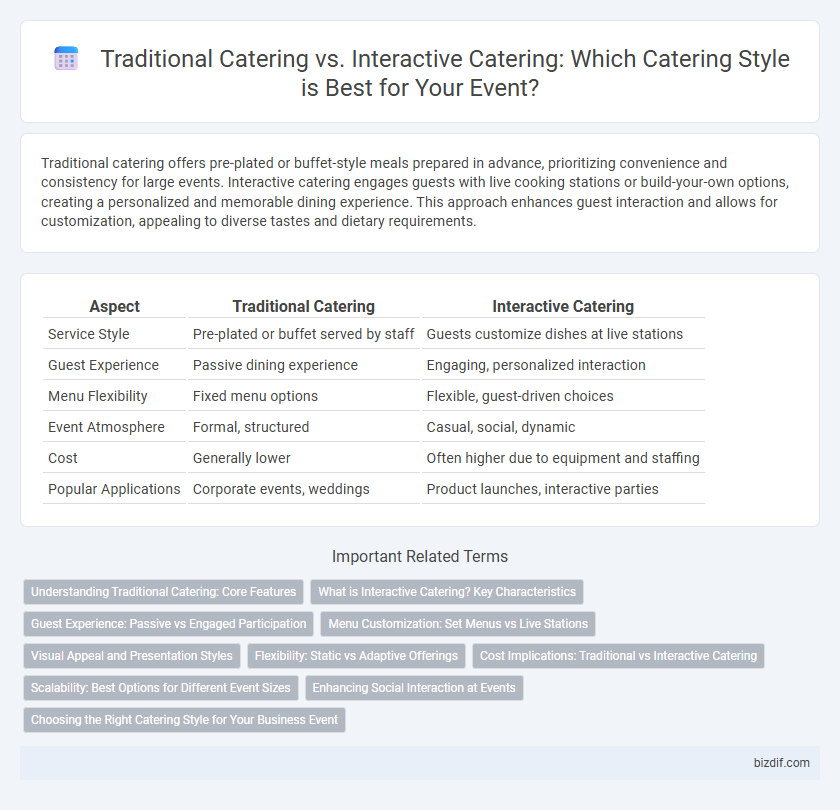Traditional catering offers pre-plated or buffet-style meals prepared in advance, prioritizing convenience and consistency for large events. Interactive catering engages guests with live cooking stations or build-your-own options, creating a personalized and memorable dining experience. This approach enhances guest interaction and allows for customization, appealing to diverse tastes and dietary requirements.
Table of Comparison
| Aspect | Traditional Catering | Interactive Catering |
|---|---|---|
| Service Style | Pre-plated or buffet served by staff | Guests customize dishes at live stations |
| Guest Experience | Passive dining experience | Engaging, personalized interaction |
| Menu Flexibility | Fixed menu options | Flexible, guest-driven choices |
| Event Atmosphere | Formal, structured | Casual, social, dynamic |
| Cost | Generally lower | Often higher due to equipment and staffing |
| Popular Applications | Corporate events, weddings | Product launches, interactive parties |
Understanding Traditional Catering: Core Features
Traditional catering emphasizes pre-prepared menus served in a structured, formal setting where dishes are plated and delivered by staff. Core features include fixed meal options, portion control, and consistent presentation designed for efficient service at large events. This approach prioritizes reliability, standardized quality, and streamlined operations over personalized guest interaction.
What is Interactive Catering? Key Characteristics
Interactive catering involves live food stations where chefs prepare dishes in front of guests, enhancing personalization and engagement. Key characteristics include customizable menus, real-time cooking, and direct interaction between chefs and attendees, promoting a dynamic dining experience. This style contrasts with traditional catering's pre-plated or buffet service by offering freshness and tailored options.
Guest Experience: Passive vs Engaged Participation
Traditional catering offers guests a passive experience where food is presented and served without interaction, allowing for convenience and efficiency. Interactive catering engages guests through live cooking stations or customizable dishes, enhancing participation and creating memorable moments. This engagement often leads to higher satisfaction by involving guests directly in the culinary process.
Menu Customization: Set Menus vs Live Stations
Traditional catering typically offers set menus with predetermined dishes, ensuring consistency and streamlined service for large events. Interactive catering emphasizes menu customization through live stations, where guests can personalize their meals in real time, enhancing engagement and satisfaction. The choice between set menus and live stations depends on event size, guest preferences, and desired level of interactivity.
Visual Appeal and Presentation Styles
Traditional catering emphasizes classic plating techniques with neatly arranged dishes and uniform portions, delivering a visually consistent and elegant presentation. Interactive catering enhances visual appeal by incorporating live cooking stations and customizable food displays, engaging guests through dynamic, visually stimulating experiences. Both methods prioritize aesthetics, but interactive catering offers a more immersive and personalized visual presentation style.
Flexibility: Static vs Adaptive Offerings
Traditional catering provides static menu options with predetermined dishes that limit customization for guests, ensuring consistency but reducing flexibility. Interactive catering offers adaptive offerings that allow guests to personalize their meals on-site, enhancing engagement and accommodating diverse dietary preferences. This flexibility makes interactive catering ideal for dynamic events requiring tailored culinary experiences and instant adjustments.
Cost Implications: Traditional vs Interactive Catering
Traditional catering typically involves fixed menus and bulk preparation, resulting in more predictable and often lower overall costs due to economies of scale. Interactive catering, featuring live cooking stations and personalized food options, usually incurs higher expenses from specialized staff and equipment, increasing the overall budget. Businesses must weigh the premium pricing of interactive experiences against the cost-effectiveness of traditional buffet or plated service models.
Scalability: Best Options for Different Event Sizes
Traditional catering offers reliable scalability for large events by providing pre-planned menus and bulk food preparation, ensuring consistent service and efficient portion control. Interactive catering excels in smaller to mid-sized gatherings, allowing personalized food stations and guest participation that enhance the experience without overwhelming logistics. Event planners can choose traditional catering for high-volume scalability or interactive catering for customized engagement in manageable group sizes.
Enhancing Social Interaction at Events
Traditional catering typically involves pre-plated meals or buffet-style service that emphasizes convenience and efficiency but offers limited opportunities for guest interaction. Interactive catering enhances social engagement by incorporating live cooking stations, customizable menus, and chef-led demonstrations, encouraging guests to connect over shared culinary experiences. This dynamic approach fosters a lively atmosphere where guests actively participate, promoting networking and memorable social interactions.
Choosing the Right Catering Style for Your Business Event
Traditional catering offers structured service with pre-plated or buffet-style meals, ensuring efficiency and consistent presentation for large business events. Interactive catering engages guests through live cooking stations and customizable menus, fostering networking and personalized dining experiences. Selecting the right catering style depends on event goals, guest preferences, and the desired level of interaction to enhance overall satisfaction.
Traditional catering vs Interactive catering Infographic

 bizdif.com
bizdif.com